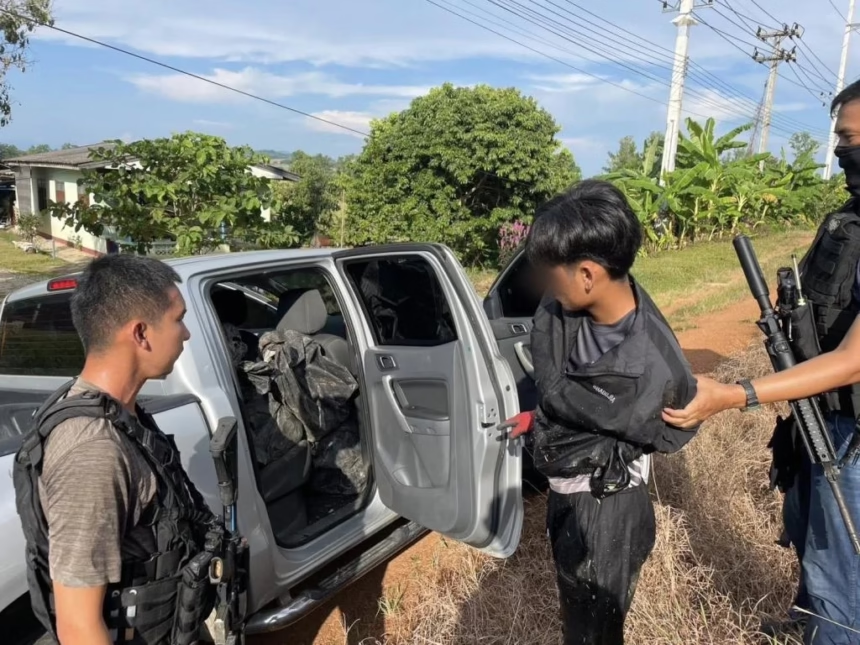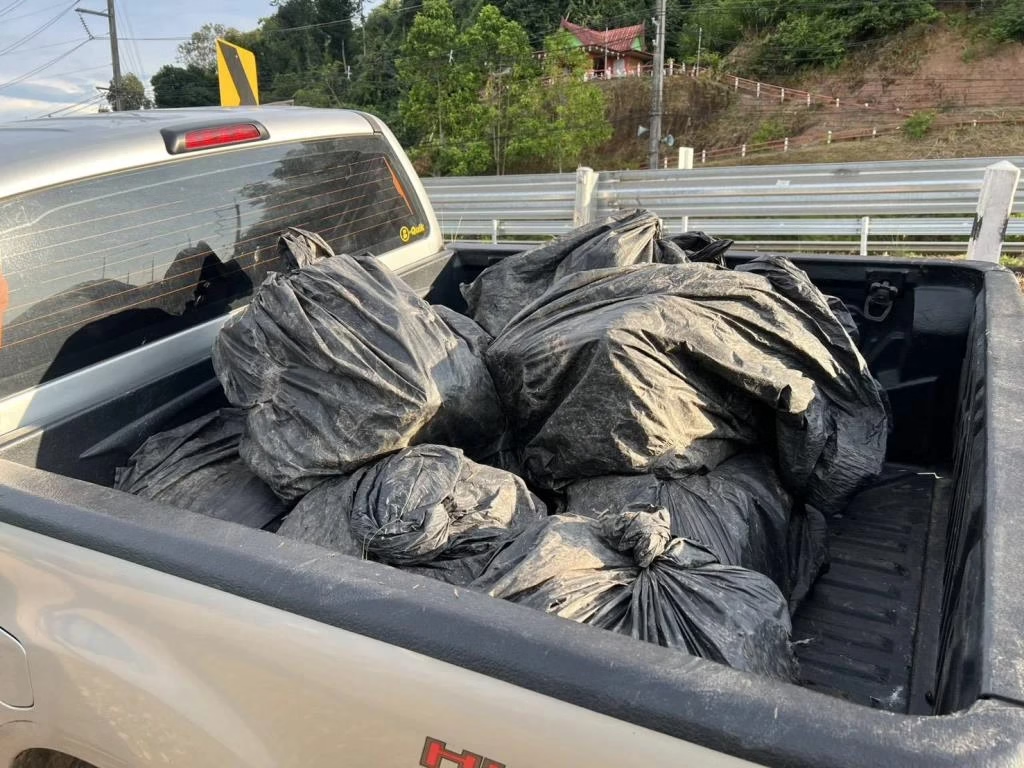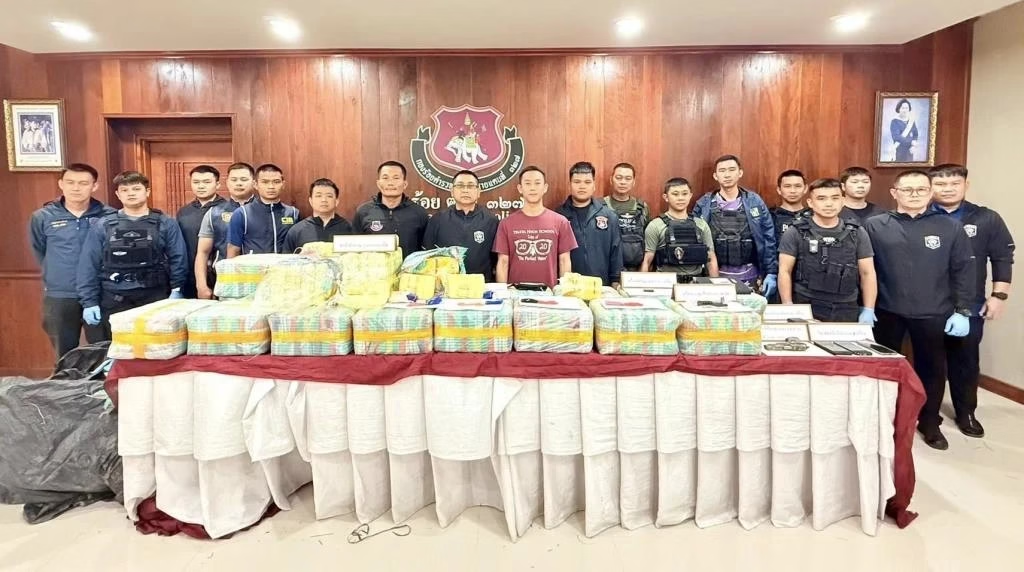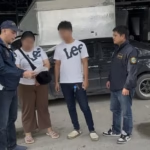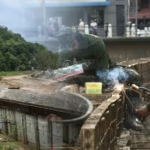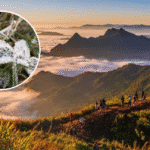CHIANG RAI – Border Patrol Police mounted a major chase and gunfight in Chiang Saen, then sealed off the area and disarmed two suspects who tried to flee in a pickup late at night. Officers seized more than 2,000,000 methamphetamine pills at the scene.
Units from Company 327, Battalion 32, Border Patrol Police Region 3, working with the Centre for Narcotics Suppression, received intelligence that a trafficking ring would move a large shipment from the Thai–Lao border near Chiang Saen.
The drugs were expected to travel by Toyota pickup along Highway 1016, the Chiang Rai–Chiang Saen route.
Pol Lt Gen Rungroj Thakurapunyasiri, Commander of the Border Patrol Police, and Pol Maj Gen Worapat Bunma, Commander of Region 3, ordered a full interception through the night of 13 to 14 October. Around midnight, officers spotted a silver Toyota pickup matching the alert, heading from the border towards Mueang Chiang Rai.
Teams moved to block the vehicle near the Doi Champi Shrine in Doi Champi village, Moo 7, Pa Sak subdistrict, Chiang Saen. The suspects opened fire with a handgun, sparking an exchange of shots, then tried to escape down a side street.
Police surrounded the area. They regained control, disarmed the suspects, and arrested the driver. A second man who fled the vehicle was tracked down and detained. One suspect was injured during the clash and was taken to the hospital.
A search of the pickup found more than ten fertilizer sacks wrapped in black plastic. Inside, officers counted about 2,080,000 methamphetamine pills. They also seized a Sig Sauer handgun and several mobile phone signal jammers.
Both suspects and the seized items were handed over for legal proceedings. The case underscores tight narcotics enforcement along the Thai–Lao border in Chiang Rai, especially on key routes like Highway 1016.
Chiang Rai Border Security
Chiang Rai sits on the front line against a steady flow of narcotics from Myanmar and Laos. The province lies in the Golden Triangle, where the three countries meet, and has long been a key corridor for smugglers. Much of the supply traces back to Myanmar’s Shan State, the world’s main source of methamphetamine.
In 2025, Thai authorities ramped up pressure on trafficking networks with a mix of force, targeted raids, and modern tools. The Pha Muang Task Force, a specialist unit of the Royal Thai Army, leads the effort. Its troops patrol more than 933 kilometres of tough border terrain, across the Mekong River with Laos and the Sai River with Myanmar.
The national drive, No Drugs, No Dealers: Toward Zero Drugs Thailand, launched in August by Deputy Prime Minister Phumtham Wechayachai, has pushed enforcement to new levels.
Mobile X-ray scanners from earlier programmes now screen suspect vehicles at checkpoints. Joint teams from the Narcotics Suppression Bureau and local police strike supply lines and storage sites.
From October 2024 to August 2025, seizures in Chiang Rai and neighbouring Chiang Mai surged.
Authorities confiscated:
- 222 million methamphetamine pills
- 11.5 tonnes of crystal meth
- 1.8 tonnes of ketamine
- 200 kilograms of heroin
- 155 kilograms of opium
The street value runs into billions of baht. Pill seizures rose 172 percent in 2023, a sign that smugglers are pushing more stock in response to tighter controls.
Recent cases show the pace and reach of the crackdown. On 18 February in Wiang Kaen District near Laos, a joint sweep led by Chiang Rai Governor Charin Thongsuk found 6 million meth pills hidden in a border village.
In March, Navy officers on the Mekong stopped a boat near Chiang Saen and seized another 6 million pills from a Lao smuggler. That same month, Pha Muang soldiers seized 323 kilograms of crystal meth after an exchange of fire at Sai Lom Joy Market in Mae Sai.
In April, police arrested four suspects in Mae Sai and uncovered 200,000 pills at a temple hideout in a lychee orchard. In May, six more suspects were detained, and a mixed load of drugs weighing over a ton was seized from a cross-border group. In June, stakeouts on vehicles in Mae Fa Luang stopped a further 6 million pills.
Violence has flared. On 22 June, a Pha Muang gunfight left two traffickers dead and 4 million pills recovered. In September, an ambush at Doi Mae Salong stopped a fleeing caravan and yielded 4.3 million tablets. By mid-year, regional seizures linked to these sweeps totalled 36 billion baht. A clash in January added 452 kilograms of ice and 960,000 pills to the haul.
These actions have disrupted known routes. Smugglers are trying to shift loads through Laos or via mountain tracks into Chiang Mai. The wider picture remains tough. Unrest in Myanmar since the coup has driven up production, with drug money arming some ethnic militias. UNODC reports say meth seizures across East Asia have hit record levels, yet prices have fallen, which points to oversupply.
Thailand’s response is broad and persistent. By mid-2025, more than 300 raids had been carried out and 347 suspects arrested. Every arrest and seizure takes drugs off the streets and reduces harm. Keeping borders tight and operations active is key to pushing towards a safer, drug-free future.




